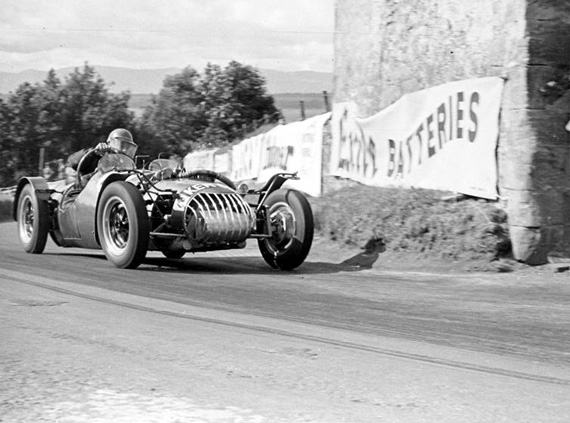
Peter Hughes photographed in action with the Tojeiro JAP at Bo’ness hill Climb in 1953. Struggling with it, as you can see by the arm action. (Photo Graham Gauld.)
By Graham Gauld
Regular readers will know that whatever historic race meeting I go to I tend to sniff around all the paddocks looking for cars that I either have never seen before or ones that I have not seen for years. At the Silverstone Classic July 30-31, there were a few and, of course, behind every car lies a story.
The Silverstone Classic this year had a stunningly huge entry of cars with races over three days from sports cars to 3 liter Formula 1 and World Championship Sports Cars. Naturally, I ignored the cars familiar to us – the Ferrari Breadvan, who wants another story about that ? – and the like, so I would rather concentrate on three cars with stories behind them. They may not be famous cars but they certainly have a history.
The Tojeiro-JAP
The first one, a Tojeiro-JAP, brought back early memories as it was racing in Scotland in the early 1950s when I was much younger. The JAP bit stood for
(J.A.Prestwich) who built engines for speedway bikes and supplied a V-twin engine to Morgan in the 1930s for the Morgan 3-wheeler. By the 1950s some of the drivers in the low-cost 500cc Formula 3 championship started to put the V-twin into their Coopers and created a pretty potent hill climb car. The Prestwich company first built engines in 1902 and were used in the early cyclecars; they made their first V-twin in 1914!
John Tojeiro, born in Portugal but raised in England, first met Brian Lister – remember the Lister-Jaguars and Lister-Corvettes – when they were at school together. When Brian Lister started racing he bought a Cooper sports car chassis and used an MG engine but did not like the car so sold it. He then got in touch with John Tojeiro and asked him to build him a car.
When it came to an engine for the car, Brian Lister had this to say: “I considered having normal water cooling but a radiator was a considerable weight handicap and therefore an air-cooled engine seemed to be the right way to go. I was looking for something that would be suitable for hill climbs and sprints as well as short races. I read an article where there was a description of someone who had taken the JAP 1100cc motorcycle engine and made up a bell housing to mate up with a Jowett Jupiter gearbox. I thought this would save a bit of money so bought one of these bell-housings.”
Tojeiro’s car was a true lightweight with cycle wings and hardly any bodywork. Lister decided to call it the “Asteroid” but in fact it was always referred to as the Tojeiro-JAP and it was the only Tojeiro ever built with that engine.
Talking to Brian Lister about the car twenty years ago, he told me it was a devil to drive and tended to dart across the road to the right and then the left. So he loaned it to another friend who had recently started racing, Archie Scott-Brown. Archie, of course, was to become Lister’s number one driver once Brian started to build his own Lister-Bristols and Lister-Jaguars.
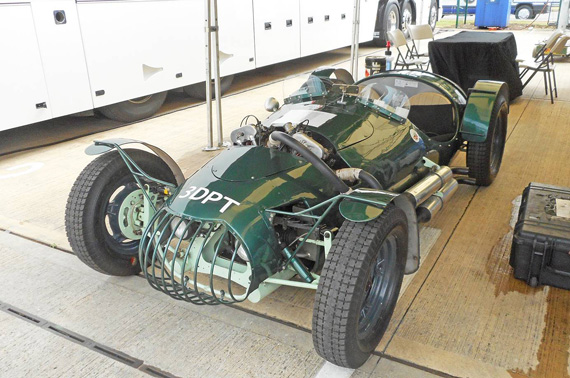
The Tojeiro-JAP at Silverstone. You can see the tops of the two cylinder heads poking out of the hood. (Photo Graham Gauld)
Archie showed what the car could do, achieving eleven wins. But Brian wanted to move on and a pal of Archie’s, a Scotsman called Peter Hughes, bought it and brought it to Scotland which is where I first saw it in action. As a spectator the car looked evil on a hill climb and it truly did need great skill to drive it fast. Peter bought it in 1953, used it a lot and then sold it and it disappeared. When I wrote John Tojeiro’s biography I simply could not find its history. So imagine my surprise when there it was at Silverstone, not racing, but amongst some of the other cars noted preparation specialist Ian Nuttall had in his pit. True at the front it did not look right but close inspection of the rest of the car certainly confirmed that this was the early Tojeiro – it was the second Tojeiro built – and I look forward to hearing more about what happened next and when I do I will let you know.
The Walled Tyrrell 010
The year was 1980, Ken Tyrrell was at the height of his career in Formula 1 and his designer Maurice Philippe came up with the model 010. It did not have a great debut in the South African Grand Prix. For a start Derek Daly had a huge accident that almost totally destroyed Chassis 2 due to the suspension breaking. At Monaco Derek again crashed, this time Chassis 3 and it never raced again. (02 was later rebuilt however).
So it was a pretty poor season all round and for 1981 Tyrrell signed American Eddie Cheever and partnered him with one of Formula 1’s all time nice guys, Michele Alboreto. As the new Tyrrell 011 was not yet ready Michele ran the last 010 chassis, 010/1 in his first race for the team in the San Marino Grand Prix that year. Up to then Tyrrell had used Ricardo Zunino but now they gave Michele his chance in a Tyrrell at Imola. He had a pretty lousy start to his season crashing the car twice before the new 010/3 was ready for him. Eventually Alboreto bought 010/5 as a souvenir of his racing with Tyrell.
Now, here was this very car, finished in its Tyrrell blue, ready to race for the first time in around thirty five years.
So how did it appear at Silverstone as one of five 3 liter Formula 1 cars run by noted Ex-Lotus mechanic Colin Bennett? Bennet explains:
“We had had a lot of success in historic racing with another Tyrrell o1o and so everyone started looking for them as few of them survived. The present owner of the car approached me and told me that Michele Alboreto’s widow was having difficulty selling the car that Michele had bought as a souvenir. The trouble was that the 010 never actually set Formula 1 alight and nobody was very interested in it but thanks to the success we had had with the other Tyrrell 010 the value of the car had improved greatly and Mrs Alboreto was moving to Switzerland.
“My contact in Italy told me about it so I got them to go to her house and collect the car. To do this they actually had to take the wall down. First they took the engine out, the gearbox off, turned the car on its side and put it on the ground outside the house. They loaded all the bits and pieces and brought the car all the way from Milan to my workshop. When the FIA man came to inspect it he said this and that was wrong. But he was wrong; the bloody thing had been walled up for 18 years and so was certainly original”.
Now, here it was, immaculate to be driven by its now owner Mike Cantalon and he duly ran it in the race. So you see, there are barn finds still out there somewhere but not many that are walled into a house!
The Unique Bristol 406 Zagato
My late father-in-law, Harry Havelock Slack, added the middle name because he thought that the name Slack did not look good as a business name. I wonder if my late old friend Tony Crook ever thought of adding a middle name?
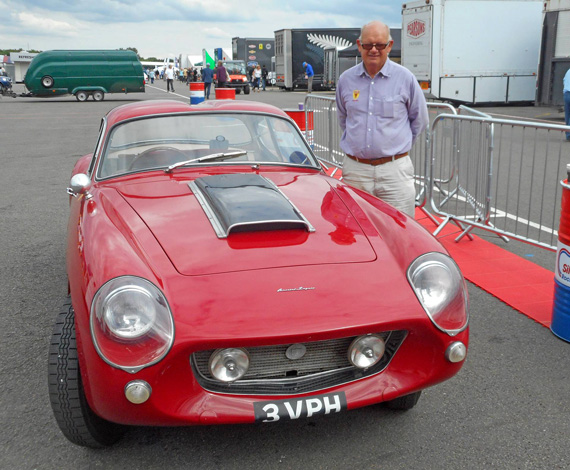
Peter Mann with the unique Bristol 506 Zagato two-seater built for Tony Crook’s wife.(Photo Graham Gauld.)
Tony was a man to be admired and respected, who could be snappy at times but he stuck to his guns. He was not only an above average racing driver but became a very individual car maker when he took over Bristol Cars back in the 1950s.
Bristols were luxury sports saloons originally powered by the BMW 328-based six-cylinder engine but suitably modified by Bristol, the English aeroplane manufacturers.
One of my earlier trips as an impoverished motoring journalist was to the Charterhall race meeting in a friend’s brand new Bristol 401 which was an elegant and fast car for its day.
Wandering through the paddock at Silverstone on Sunday I bumped into Peter Mann who is a great collector of cars and raced many of them. He and Tony Crook were great friends and years ago he had bought three of Tony Crook’s, the Cooper-Bristol F2 race car, his Frazer-Nash Le Mans Replica and his favourite Bristol 504 sedan.
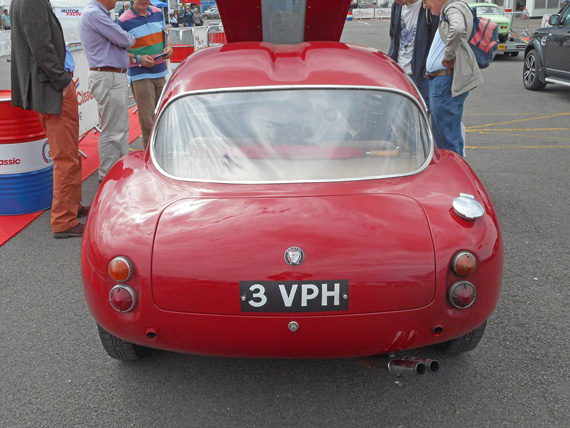
Photographed from the rear one sees the iconic double bubble roof and smooth rounded tail on this interesting car. (Photo Graham Gauld.)
However, the car Peter had with him is one Tony had told me about but I had never seen, his 406 Zagato Coupe. Tony Crook was a perfectionist – he never loaned any Bristol model to a journalist to road test so all the road tests you have ever seen were done on privately owned cars. He also liked Zagato and sent six of his latest 406 models down to Italy for Zagato to turn them into luxurious sports saloons in the Zagato style.
From time one of the five regular 406 Zagato’s comes up for auction and is immediately snapped up but the sixth one looks nothing like the others. Tony wanted it built for his wife and so it is a two seat coupe with the familiar bubble top on the roof and smooth svelte styling. It was this car that Peter Mann brought to Silverstone. He explained he had recently run it in a hill climb in Italy and it was still going well. It had a proper competition Bristol engine in it and it is immaculate. It is good to see that such a unique car is in pretty safe hands.
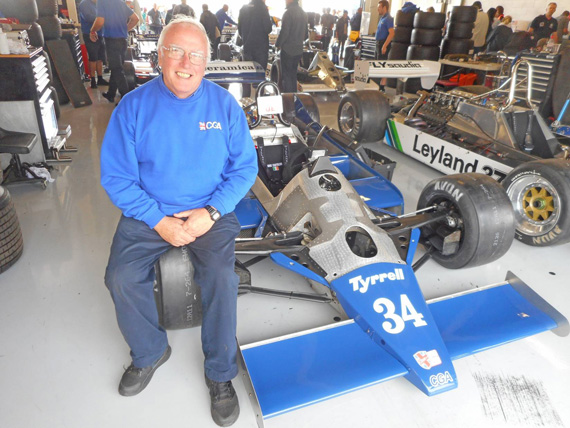
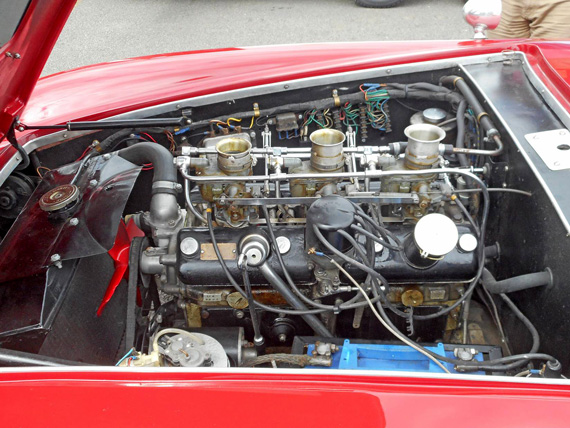
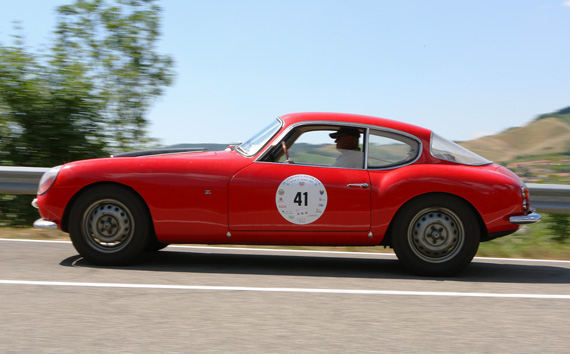
Graham – because you ‘sniff’ around looking for something different that’s why your stories are so good. Too many mags just seem to regurgitate the “SOS”
(Same old s…)
More good Graham Gauld stories—
Tony Crook was a remarkable man
and some enthusiast. Pre-war in England
there were just 2 examples of the mighty
Alfa Romeo 2.9…and Crook owned them both !
Earlier car shipped off in 1946 to California to
playboy Tommy Lee and now with my friend
Simon Moore.
The other spyder ran in Mille Miglia for 1938
event, sold to Hugh Hunter at end of that season
and then to Major Thomson in Scotland.
Nice to read Michele Alboreto described as ‘one of Formula 1’s all time nice guys’. Of all of the ‘stars’ I worked with over the years he is always remembered as a true gent. Thanks.
Great fun, Graham! More power to your pen and camera!
Please note that in my story about Peter Mann’s ex-Tony Crook Bristol-Zagato
I said that Tony had it commissioned for his wife. In fact he commissioned
it for his daughter Carole. I rarely manage to skip generations but this
time I did.